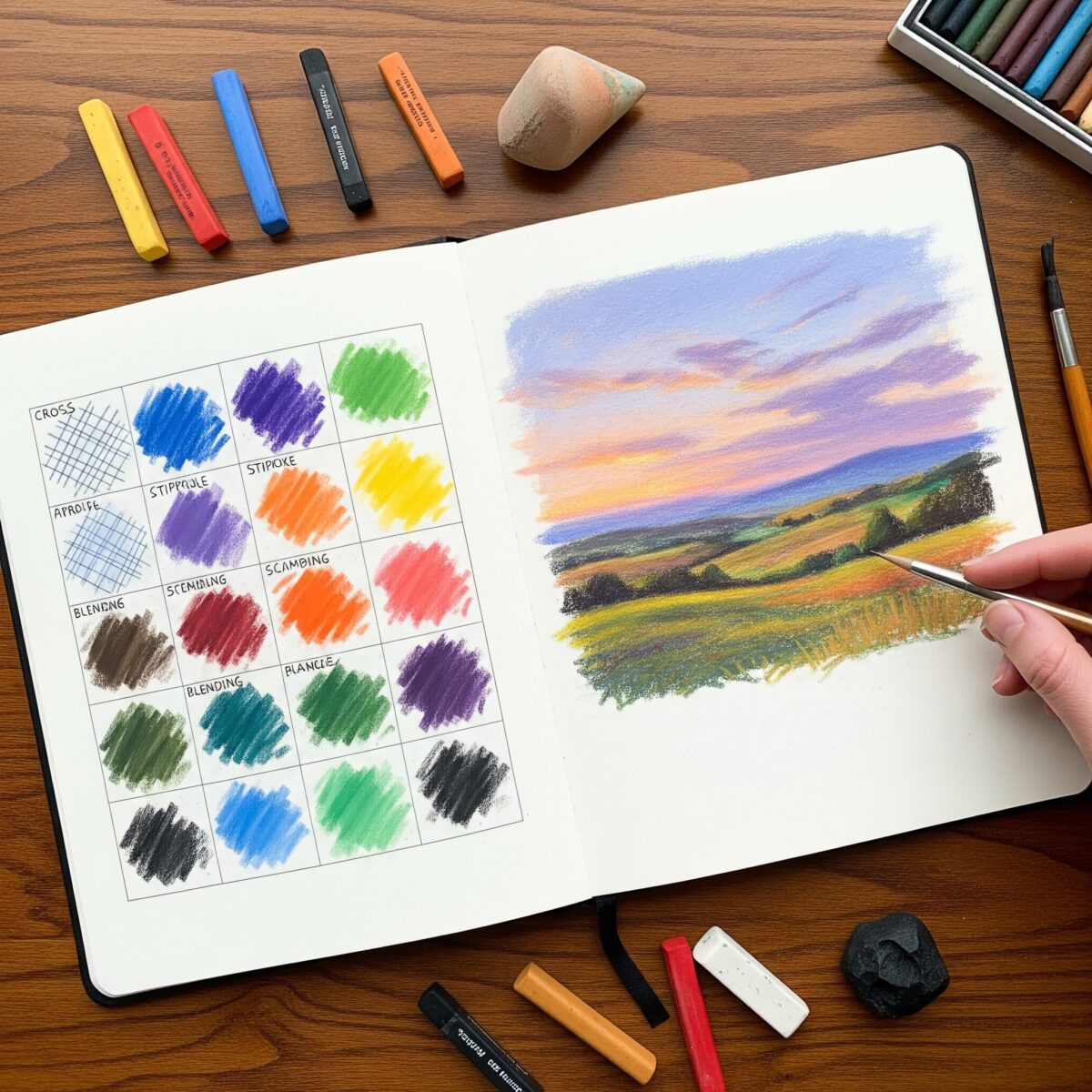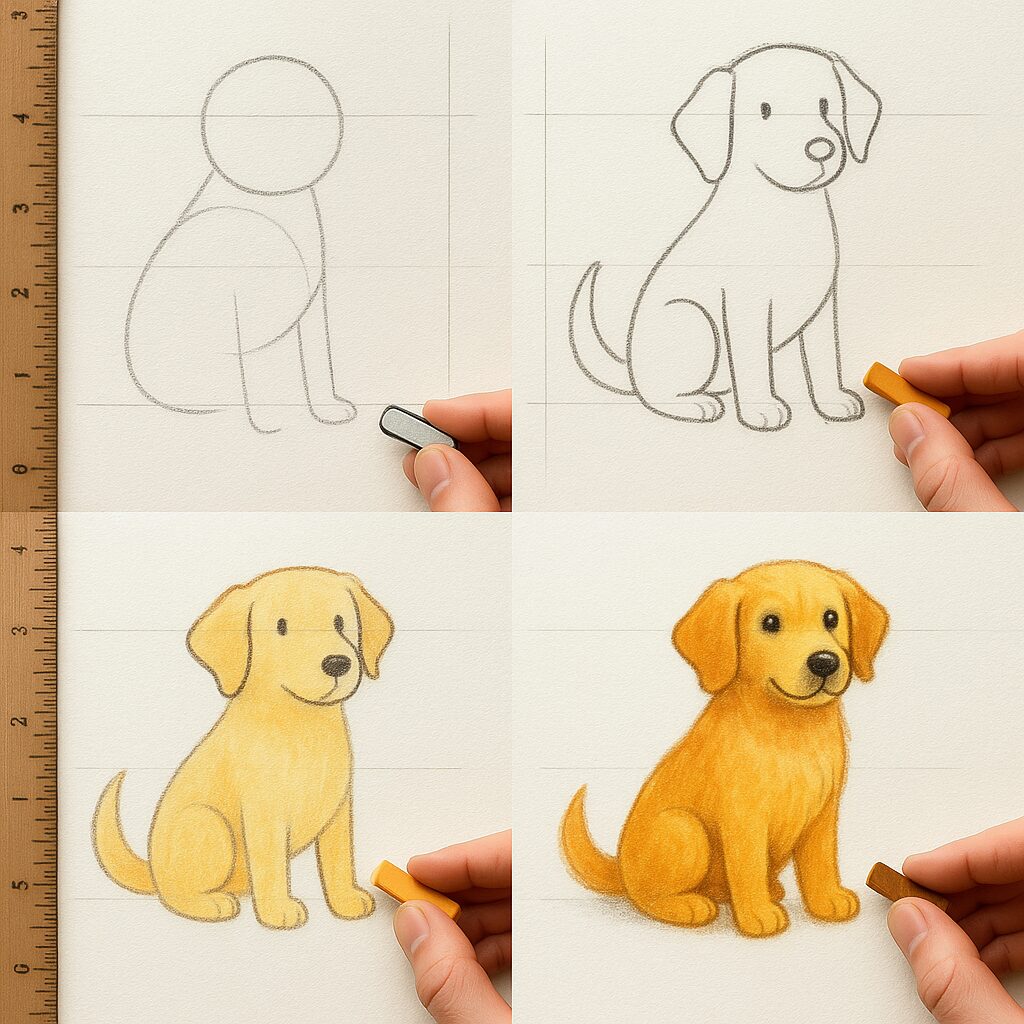Every artist knows the magic of opening a fresh sketchbook—that blank page filled with endless possibilities. Whether you’re a seasoned painter or just starting your artistic journey, having inspiring sketchbook ideas for artists can transform your creative practice. Pastels offer a unique medium that bridges drawing and painting, making them perfect for sketchbook exploration. These versatile tools allow you to create everything from soft, dreamy landscapes to bold, expressive portraits right in your portable art journal.
Key Points Summary:
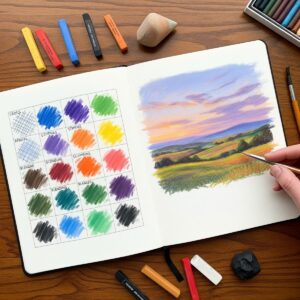
- Discover over 10 unique sketchbook techniques using pastels
- Learn how to set up your sketchbook for optimal pastel work
- Explore texture creation, blending methods, and mixed media approaches
- Find creative exercises to overcome artistic blocks
- Master the art of turning mistakes into masterpieces
- Integrate digital tools with traditional sketchbook practices
Why Choose Pastels for Your Sketchbook Adventures?
Pastels are incredibly forgiving and offer instant gratification—perfect qualities for sketchbook work. Unlike oils or acrylics that require extensive setup, pastels let you dive straight into creating. They blend beautifully, layer smoothly, and work on various paper types. Plus, there’s something deeply satisfying about the tactile experience of working with pastels directly with your fingers.
The portability factor makes pastels ideal for outdoor sketching sessions. You can capture a stunning sunset or interesting architectural details without worrying about wet paint or complicated cleanup procedures. Before diving into advanced techniques, it’s helpful to learn the basics of pastel work from established art suppliers.
Setting Up Your Sketchbook for Pastel Success
Choosing the Right Sketchbook
Not all sketchbooks work well with pastels. Look for paper with some tooth or texture—smooth paper won’t hold the pastel pigment effectively. Mixed media sketchbooks or those specifically designed for dry media work best. The paper should be thick enough (at least 140gsm) to handle multiple layers without buckling.
| Paper Type | Best For | Pros | Cons |
|---|---|---|---|
| Textured Drawing Paper | Detailed work | Holds pigment well | Can be expensive |
| Mixed Media Paper | Versatility | Works with multiple mediums | May not be optimal for any single medium |
| Newsprint | Practice sketches | Affordable | Tears easily |
| Toned Paper | Dramatic effects | Provides middle value | Limited color options |
Organizing Your Pastels
Keep your pastels organized by color families or values. Many artists use small containers or even egg cartons to separate different hues. This organization saves time and keeps your creative flow uninterrupted.
Essential Pastel Techniques for Sketchbook Artists
Blending and Smudging
Start with basic blending techniques using your fingers, blending stumps, or even cotton swabs. Practice creating smooth gradients from light to dark. This fundamental skill forms the foundation for more advanced techniques. Understanding these dry media approaches can complement other artistic methods, similar to exploring dry media techniques used in watercolor pencil work.
“The beauty of pastels lies in their ability to create soft, atmospheric effects that would be difficult to achieve with other mediums.”
Layering Colors
Build up colors gradually rather than applying heavy pressure initially. Light layers allow you to control the intensity and create more nuanced color relationships. This technique proves especially useful when working on mixed media art techniques.
Creating Texture
Experiment with different application methods:
- Side strokes for broad areas
- Tip work for fine details
- Cross-hatching for texture
- Stippling for unique surface effects
Just as artists find inspiration through unconventional tools for artistic expression, you can use various household items to create unique textures with pastels.
Creative Sketchbook Ideas for Artists Using Pastels
Daily Color Studies
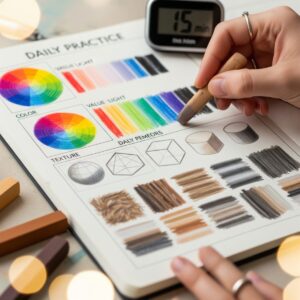
Dedicate one page each day to exploring a single color family. Start with just three pastels—a light, medium, and dark version of the same hue. Practice creating various textures, patterns, and gradients. This exercise builds color confidence and improves your understanding of value relationships.
Emotion-Based Pages
Choose an emotion and express it entirely through color and texture. Anger might be sharp, jagged strokes in reds and oranges, while peace could be soft blues and greens with gentle, flowing movements. This approach helps develop your personal artistic voice.
Quick Gesture Sketches
Set a timer for 5 minutes and capture the essence of a subject—a pet, a plant, or even a household object. Focus on overall shapes and major color areas rather than details. These exercises improve your ability to see and capture essential elements quickly.
Texture Exploration Pages
Create abstract compositions focusing solely on different textures. Try representing various surfaces like tree bark, flowing water, smooth stones, or fluffy clouds. Use different pastel application techniques to achieve unique effects.
Monochrome Value Studies
Choose one color and create entire compositions using only different values of that hue. This exercise strengthens your understanding of light, shadow, and form without the complexity of multiple colors.
Mixed Media Magic in Your Sketchbook
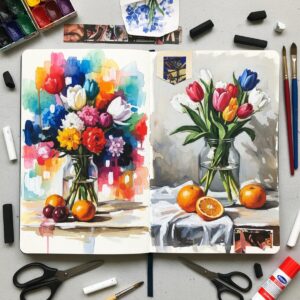
Combining pastels with other media creates exciting visual possibilities. For more advanced approaches, explore professional mixed media techniques that can elevate your sketchbook work. Try these combinations:
- Ink and Pastels: Start with ink line drawings and add pastel color
- Collage Elements: Incorporate fabric scraps, magazine cutouts, or interesting papers
- Watercolor Underpainting: Let watercolor dry completely, then add pastel details
- Charcoal Foundations: Use charcoal for initial value studies, then add pastel color
These mixed approaches often lead to unexpected discoveries and help expand your artistic vocabulary.
Overcoming Creative Blocks with Sketchbook Exercises
Every artist faces creative blocks. Your sketchbook becomes a powerful tool for pushing through these challenging periods. When you feel stuck, try these creative sketchbook ideas for artists:
The Random Page Challenge
Flip to any page in an old magazine, close your eyes, and point to an image. Use that image as inspiration for a pastel study. This random approach often leads to subjects you’d never normally choose, expanding your artistic horizons.
Blind Contour Drawing with Pastels
Draw your subject without looking at the paper, then add color and shading while looking. The resulting images often have a loose, expressive quality that’s both charming and instructive.
Time-Limited Challenges
Set progressively shorter time limits for completing sketches—start with 30 minutes, then 15, then 5. This pressure forces you to focus on essential elements and can help you overcome creative blocks.
Turning Mistakes into Masterpieces
Pastels are incredibly forgiving, making them perfect for learning to embrace artistic “mistakes.” That accidental smudge might become a perfect cloud. The color that seemed too bright could work beautifully as an unexpected highlight.
Keep a dedicated section in your sketchbook for experimental pages where anything goes. These freedom pages often produce your most innovative work because they’re free from the pressure of creating something “perfect.”
Digital Integration with Traditional Sketchbook Work
Modern artists often blend digital and traditional techniques. Consider digitizing traditional artwork to create digital portfolios or share your sketchbook work online.
Use your smartphone to photograph work-in-progress shots, creating time-lapse videos of your creative process. These documentation methods help you analyze your techniques and share your artistic journey with others.
Many artists find that photographing their sketchbook pages in different lighting conditions reveals new aspects of their work and provides inspiration for future pieces.
Building Your Sketchbook Practice
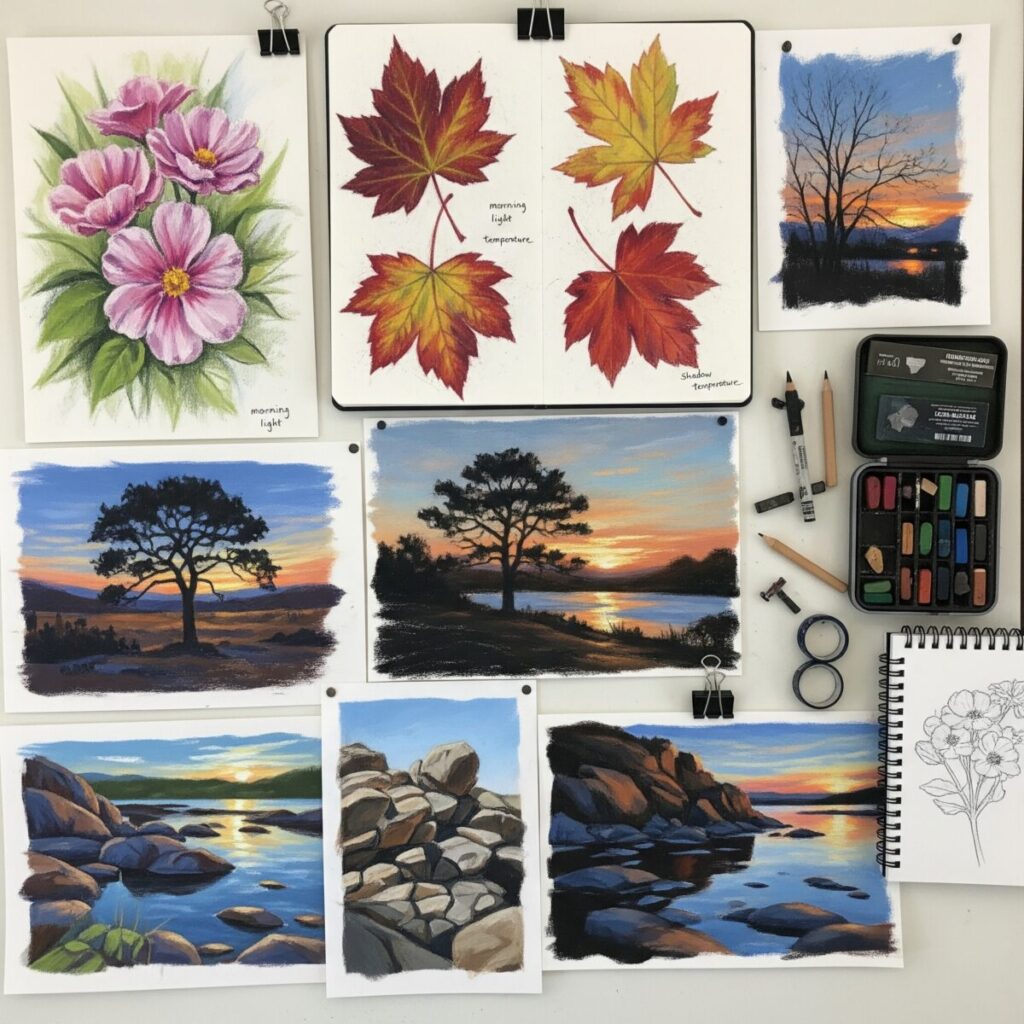
Consistency trumps perfection when developing your artistic skills. Aim for regular sketchbook sessions, even if they’re just 10-15 minutes long. Carry a small travel sketchbook for capturing inspiration wherever you go.
Review your older sketchbook pages regularly. You’ll be amazed at your progress and might rediscover forgotten techniques or ideas worth revisiting. Consider dating your pages to track your artistic evolution over time.
Remember that sketchbooks are meant for exploration and experimentation, not museum-quality finished pieces. Embrace the messy, imperfect, learning-focused nature of sketchbook work.
When you’re ready to expand your practice, invest in quality materials from trusted sources offering the best sketchbooks for practicing artists to support your growing skills. Your sketchbook becomes a visual diary of your artistic growth, capturing not just images but also your evolving relationship with art. These sketchbook ideas for artists using pastels provide endless opportunities for creative exploration and skill development. Whether you’re working through specific exercises or simply playing with color and texture, your sketchbook remains your most valuable artistic companion—always ready for the next creative adventure.
Frequently Asked Questions
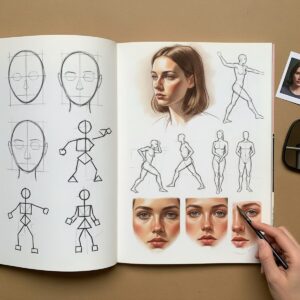
What are the best sketchbook ideas for beginner artists? Start with simple daily exercises like gesture drawings, color studies, and texture exploration. Focus on one technique at a time and practice consistently rather than trying to master everything at once.
How do I start an art journal? Begin by choosing a sketchbook with appropriate paper for your preferred medium. Set aside dedicated time each day, even if just 10 minutes, and focus on experimentation rather than perfection.
What are good drawing practice exercises? Try blind contour drawing, value studies, gesture sketches, and copying master works. Vary your subjects and time limits to build different skills.
Which is the best sketchbook for pastels? Look for mixed media paper or textured drawing paper with at least 140gsm weight. Brands like Strathmore, Canson, and Fabriano offer excellent options for pastel work.
What are creative ways to use pastels in art? Experiment with blending techniques, layering colors, creating textures with different application methods, and combining pastels with other media like ink or watercolor for mixed media effects.

